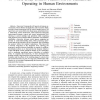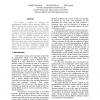215 search results - page 26 / 43 » Feature-based locomotion controllers |
GECCO
2009
Springer
14 years 3 months ago
2009
Springer
Embodied cognition emphasizes that intelligent behavior results from the coupled dynamics between an agent’s body, brain and environment. In response to this, several projects h...
ICRA
2006
IEEE
14 years 2 months ago
2006
IEEE
Abstract— Tomorrow’s humanoids will operate in human environments, where efficient manipulation and locomotion skills, and safe contact interactions will be critical design fa...
IROS
2007
IEEE
14 years 2 months ago
2007
IEEE
— High-speed legged locomotion is complicated by the challenge of uneven terrain because the system must respond to the fast-changing terrain elevation under each foot, and quick...
AMS
2007
Springer
14 years 2 months ago
2007
Springer
Abstract Walking, running and hopping are based on self-stabilizing oscillatory activity. In contrast, aiming movements serve to direct a limb to a desired location and demand a qu...
EH
2005
IEEE
14 years 2 months ago
2005
IEEE
We present a method for evolving and implementing artificial neural networks (ANNs) on Field Programmable Analog Arrays (FPAAs). These FPAAs offer the small size and low power usa...


